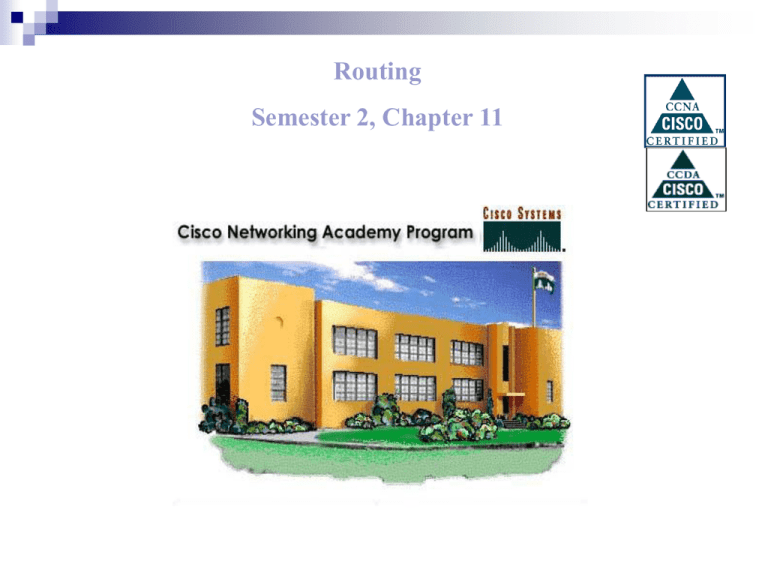Routing
advertisement

Routing Semester 2, Chapter 11 Routing Routing Basics Distance Vector Routing Link-State Routing Comparisons of Routing Protocols Network Layer Addressing, Routing, & Switching Best effort delivery of packets Routed Protocols Routing Protocols maintain routing tables path selection limit broadcasts Static Routes Determined by admin Reveals only information that you want to show about your network Less overhead on network Good for stub networks that only have one connection What happens if route fails?? Dynamic Routes Routing protocol makes automatic adjustments on routes based on traffic, topology and other metrics Reveals information about your network - security? Less involvement by admin Depend on timely updates of configuration to routing tables routing protocol describes: how to send updates what knowledge is contained in these updates when to send this knowledge how to locate recipients of the updates Metrics used by routers Bandwidth delay load reliability hop count ticks cost Routing Protocols Distance Vector Link State Convergence The distance-vector routing approach determines the direction (vector) and distance to any link in the internetwork. The link-state (also called shortest path first) approach re-creates the exact topology of the entire internetwork (or at least the partition in which the router is situated). The balanced hybrid approach combines aspects of the link-state and distance-vector algorithms. Define Convergence The routing algorithm is fundamental to dynamic routing. Whenever the topology of a network changes because of growth, reconfiguration, or failure, the network knowledge base must also change. Default Route A routing table entry that sends data to next hop when that entry is not specified in the routing table Can be used to reach any unknown destination Default Route Lab Distance Vector Each router gets routing tables from its neighbors (remember the outcome of the Show IP Route command) Routers determine best path based on info from their neighbors – accumulated distance – hops Convergence – time for tables to update after change in topology Errors in Routing Routing Loops Count to infinity Solution Define a maximum – 15 hops Split Horizon Hold Down timers – inaccessible routes marked with timers Define Routing Loops. Routing loops can occur if a network’s slow convergence on a new configuration causes inconsistent routing entries The invalid updates of Network 1 will continue to loop until some other process stops the looping. This condition, called count to infinity, loops packets continuously around the network in spite of the fundamental fact that the destination network, Network 1, is down. While the routers are counting to infinity, the invalid information allows a routing loop to exist. Distance-vector routing algorithms are self-correcting, but a routing loop problem can require a count to infinity first. To avoid this prolonged problem, distance-vector protocols define infinity as a specific maximum number. This number refers to a routing metric (e.g. a simple hop count). Another possible source for a routing loop occurs when incorrect information that has been sent back to a router contradicts the correct information that it sent. Split-horizon attempts to avoid this situation. Split-horizon thus reduces incorrect routing information and reduces routing overhead You can avoid a count to infinity problem by using holddown timers. These prevent a router from using a alternative route that may have failed Link State Routing Shortest Path First Full knowledge of distant routers LSAs Topology Database SPF Algorithm Routing tables Designated Routers Two Link State Concerns CPU Usage & RAM Bandwidth Also Unsynchronized LSAs lead to inconsistent path decisions amongst routers The network layer must relate to, and interface with, various lower layers for LAN-to-WAN traffic. As an internetwork grows, the path taken by a packet may encounter several relay points and a variety of data link types beyond the LANs. Routers enable LAN-to-WAN packet flow by keeping the end-to-end source and destination addresses constant while encapsulating the packet in data link frames, as appropriate, for the next hop along the path. Typically, routers are required to support multiple protocol stacks, each with its own routing protocols, and to allow these different environments to operate in parallel. In practice, routers also incorporate bridging functions and sometimes serve as a limited form of hub. Routers are devices that implement the network service. They provide interfaces for a wide range of links and subnetworks at a wide range of speeds. Routers are active and intelligent network nodes and thus can participate in managing a network. Routers manage networks by providing dynamic control over resources and supporting the tasks and goals for internetworks connectivity, reliable performance, management control, and flexibility. End of Chapter 11 Chapter 11 Test Next Week


![Internetworking Technologies [Opens in New Window]](http://s3.studylib.net/store/data/007474950_1-04ba8ede092e0c026d6f82bb0c5b9cb6-300x300.png)




